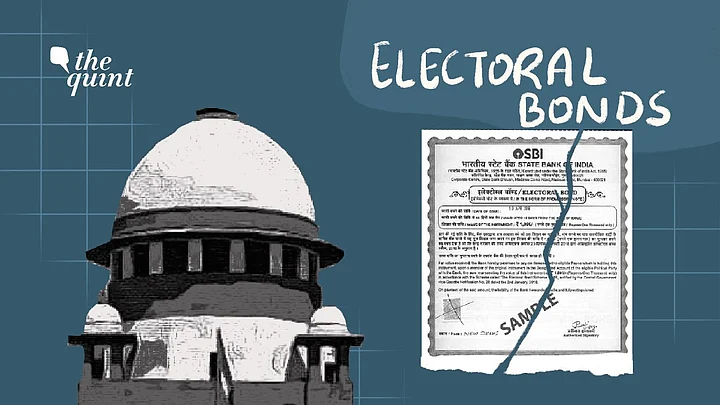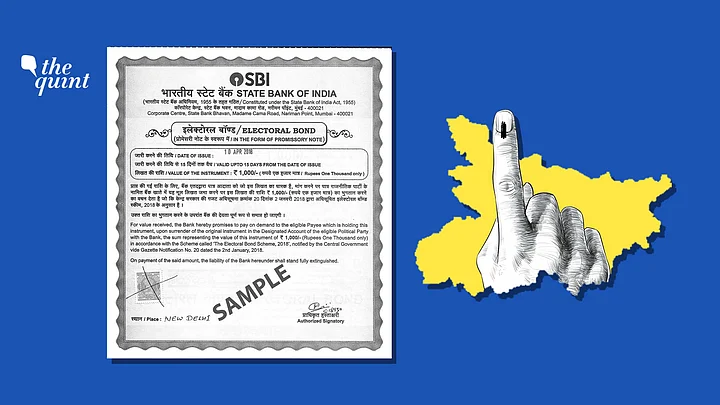The Supreme Court’s (SC) judgment that has refused to stay the issuance and sale of electoral bonds ahead of the upcoming Assembly elections has not just one but multiple loopholes, say experts.
“The judgment is disappointing but not surprising. The arguments presented by the SC in the judgment are not tenable.”Jagdeep Chhokar, Founding Member, Association for Democratic Reforms
The application seeking a stay on the sale of electoral bonds was filed by the Association for Democratic Reforms (ADR) in March 2021. The court dismissed the application on the ground that the electoral bonds scheme ‘already’ has ‘certain safeguards’.
It is worth noting that the dismissal of the interim stay application is not the end of the road for ADR. Their original petition, challenging the constitutionality of the electoral bonds is still pending in the Supreme Court.
Now let’s take a look at the loopholes in the judgment one by one.

Loophole #1
Why did the SC not open the Sealed Covers containing Donors’ Information?
The Supreme Court said,
“...they (electoral bonds) had been so released in the years 2018, 2019 and 2020 without any impediment, and certain safeguards have been provided by this Court in its interim order dated 12.4.2019, (so) we do not see any justification for the grant of stay at this stage.”The Supreme Court
Here the SC is referring to the ‘safeguards’ it provided in its 12 April 2019 order in which the court directed all political parties to disclose the details of donations received through electoral bonds to the Election Commission (EC) by 30 May 2019, in sealed envelopes.
Firstly, the SC’s interim order of 12 April 2019 was valid only till 30 May 2019.
Jagdeep Chhokar, founding member of ADR said, “The interim order is not effectively applicable on political parties after May 2019.” Therefore, political parties are under no compulsion to share the details of electoral bond donors and donations that they received after May 2019, with EC.
Secondly, information about the electoral bonds’ donors were submitted in sealed covers to the EC. But these sealed covers have not yet been opened.
“Since the sealed covers have not been opened, neither the EC, nor the SC, have access to information about donors and donations,” said Chhokar.
The question is – without the information within those sealed covers, how is the EC or the SC in a position to evaluate the nature of these donations? Wouldn't the information be of relevance to better rule on how effectively the electoral bonds scheme is being implemented?

Loophole #2
SC says Funding via Bonds came to a Closure but it is a Recurring Event
The Supreme Court in its judgment said,
...this Court thought fit to make an interim arrangement (with 12.4.2019 order) as it was not possible to decide all the issues within the limited time available before the process of funding through Electoral Bonds came to a closure.”The Supreme Court
“Funding through electoral bonds never came to a closure after May 2019. Bonds were scheduled for sale several times thereafter. It is a recurring event,” said Chhokar.
Till date, electoral bonds have been sold in 15 tranches. Of these, five tranches were sold after 10 May 2019, between July 2019 and January 2021. Information received through RTI reveals that electoral bonds sold between the 11th and 14th tranches were worth Rs 641.27 crore. Data for the 15th tranche is not available in the public domain.
The question is – does EC or SC know who donated over Rs 641.27 crore and to which political parties? Electoral bonds will be sold once again, from 1 April onwards. Once again, no one will know who the donors are.

Loophole #3
RBI’s Recommendations Violated
The SC said that, “most of the recommendations of the RBI have been accepted and incorporated in the Scheme”.
But that’s not true.
One of the RBI’s recommendations was “only political parties registered under Section 29A of the Representation of the People Act, 1951 and securing not less than 1% of the votes polled in the last general election to the house of the people or the legislative assembly, shall be entitled to receive the bond.”
“This recommendation has already been violated. Data is available on this violation which shows that many registered unrecognised parties who got less than 1% or no votes, have got electoral bonds,” said Chhokar.
As per data analysis by ADR which was based on RTI information received from EC, as many as 105 political parties submitted electoral bonds’ donors details in a sealed cover with the EC.
Of these 105 political parties, as many as 69 were registered but unrecognised parties. In other words, these political parties are registered with the EC but are not recognised parties.
Further analysis by ADR reveals that the vote share of 42 parties that submitted details of donations received through electoral bonds, range between a maximum of 0.86% and a minimum of 0.0003%.
Clearly, these 42 political parties do not fulfil the criteria of securing 1% of vote share. Then how can SC say that RBI recommendations were fulfilled?

Loophole #4
“Discussion Does Not Mean Acceptance”
The RBI, through multiple letters to the Finance Ministry, objected to the sale of electoral bonds in scrip or physical form, pointing to a “serious risk of money laundering” as the bonds may pass through multiple hands before being credited to a political party.
In another letter, the RBI also said that electoral bonds should be issued in demat or electronic form. “If the government is agreeable to revisit its stance on issuing EBs in scrip form, we can discuss the modalities of issuance of electoral bonds in demat form,” said RBI.
The SC does take note of the RBI letters and the details mentioned above and goes on to say,
“...it is incorrect to say that the RBI was opposed to the Scheme in principle. RBI’s objection was to the issue of bonds in scrip form rather than in demat form.”The Supreme Court
Firstly, the electoral bonds are still sold in scrip form and not demat form. Which means the RBI’s objections have not been addressed.
Secondly, the RBI in its letter clearly states that it is open to “discuss the modalities of issuance of electoral bonds in demat form,” – Chhokar said, “discussion does not mean acceptance by the RBI.”
Then how can the SC say, “most of the recommendations of the RBI have been accepted and incorporated in the Scheme” when a key issue of scrip versus demat form, was not resolved by the Finance Ministry?

Loophole #5
“Govt could be Aware of Electoral Bonds Donors”: SC
“The Government may be in a position to find out the names of the donors. As the Scheme operates through the State Bank of India via banking channels, members of the public and political parties not in power, will not be able to find out.”The Supreme Court
The electoral bonds scheme was introduced by the BJP-led government in 2018 claiming to maintain the anonymity of the donors.
The Quint through its investigative report had revealed that electoral bonds carry a hidden unique alphanumeric code through which donors could be tracked by the State Bank of India (SBI) which is the only bank authorised to sell bonds. The SBI would not just know the names of the donors but with the unique code it would be able to find out which donor donated the bond to which political party.
Now, since the data is available with the SBI, the government can easily access it. Hence, the government’s claim that donors identity will remain anonymous falls flat.
“Selective anonymity is dangerous for the society,” said Chhokar.
Secondly, only the government or the ruling political party is aware of the identity of the donors and not the public nor opposition political parties. Does this not make the donors who donated to opposition parties vulnerable to attacks by the ruling party?
Is it fair in a democracy that only the ruling political party and not the opposition party or public are aware of the names of the donors of electoral bonds?

Loophole #6
The SC said, “the apprehension that foreign corporate houses may buy the bonds and attempt to influence the electoral process in the country is also misconceived”.
But it is actually not “misconceived”.
As per the notification issued by the SBI, “a Person, who is a Citizen of India or Incorporated or Established in India” can purchase electoral bonds. The definition of Person includes a Company, a Firm an Association of Persons or a Body of Individuals, any Agency, Office or Branch.
“Going by the SBI’s notification on who can purchase electoral bonds, a foreign company’s subsidiary which is registered in India can purchase electoral bonds. Doesn't that allow foreign corporates and foreign funds to be used for electoral bonds?” asks Chhokar.
And how would anyone be sure that foreign governments, even hostile governments, are not in turn funding or backing any foreign corporate interests in electoral bonds?
Multiple media reports based on RTI replies reveal fears and concerns raised by the Election Commission, the RBI and the Law Ministry. All this was known to the Supreme Court, yet it chose not to stay the sale of electoral bonds.
It is inexplicable why the SC has chosen to disregard the concerns highlighted by oversight bodies like the ECI and the RBI that electoral bonds will enable money laundering and prevent scrutiny of funds received by parties.Anjali Bharadwaj, Transparency Activist
In addition, transparency activist Commodore Lokesh Batra (retd) said,
The Supreme Court had only selectively quoted from the RBI letters that raised issues about the bonds. No observations were made on concerns expressed by ECI about electoral bonds in its affidavits.Commodore Lokesh Batra (retd), Transparency Activist
Now, all hopes lie with the main petition challenging the constitutionality of the electoral bonds.
(At The Quint, we question everything. Play an active role in shaping our journalism by becoming a member today.)


